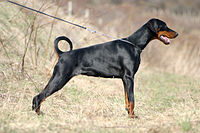
Photo from wikipedia
Background The efficacy of treatment of dogs with cervical spondylomyelopathy (CSM) is commonly based on the owner's and clinician's perception of the gait, which is highly subjective and suffers from… Click to show full abstract
Background The efficacy of treatment of dogs with cervical spondylomyelopathy (CSM) is commonly based on the owner's and clinician's perception of the gait, which is highly subjective and suffers from observer bias. Hypothesis/Objectives To compare selected kinetic and kinematic parameters before and after treatments and to correlate the findings of gait analysis to clinical outcome. Animals Eight Doberman Pinschers with CSM confirmed by magnetic resonsance imaging. Methods Patients were prospectively studied and treated with either medical management (n = 5) or surgery (n = 3). Force plate analysis and 3‐D kinematic motion capture were performed at initial presentation and approximately 8 weeks later. Force plate parameters evaluated included peak vertical force (PVF). Kinematic parameters measured included number of pelvic limb strides, stifle flexion and extension, maximum and minimum thoracic limb distance, truncal sway, and thoracic limb stride duration. Results Kinematic analysis showed that deviation of the spine to the right (truncal sway) was significantly smaller (P < .001) and the degree of right stifle flexion was significantly larger (P = .029) after treatment. Force plate analysis indicated that PVF was significantly different after treatment (P = .049) and the difference of the PVF also was significantly larger (P = .027). However, no correlation was found with either method of gait analysis and clinical recovery. Conclusions and Clinical Importance Kinetic and kinematic gait analysis were able to detect differences in dogs with CSM before and after treatment. A correlation of gait analysis to clinical improvement could not be determined.
Journal Title: Journal of Veterinary Internal Medicine
Year Published: 2018
Link to full text (if available)
Share on Social Media: Sign Up to like & get
recommendations!